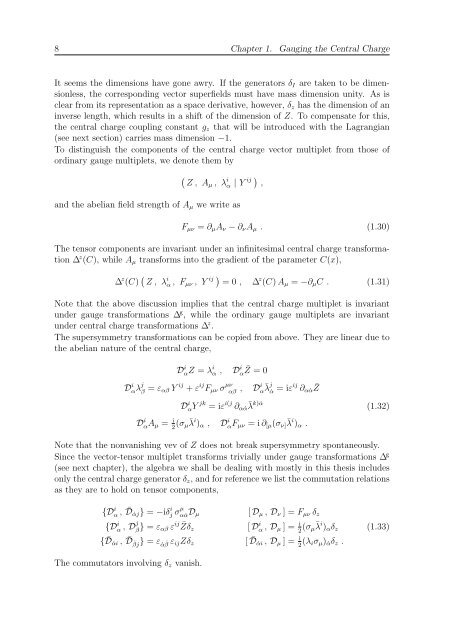N=2 Supersymmetric Gauge Theories with Nonpolynomial Interactions
N=2 Supersymmetric Gauge Theories with Nonpolynomial Interactions
N=2 Supersymmetric Gauge Theories with Nonpolynomial Interactions
You also want an ePaper? Increase the reach of your titles
YUMPU automatically turns print PDFs into web optimized ePapers that Google loves.
8 Chapter 1. Gauging the Central Charge<br />
It seems the dimensions have gone awry. If the generators δI are taken to be dimensionless,<br />
the corresponding vector superfields must have mass dimension unity. As is<br />
clear from its representation as a space derivative, however, δz has the dimension of an<br />
inverse length, which results in a shift of the dimension of Z. To compensate for this,<br />
the central charge coupling constant gz that will be introduced <strong>with</strong> the Lagrangian<br />
(see next section) carries mass dimension −1.<br />
To distinguish the components of the central charge vector multiplet from those of<br />
ordinary gauge multiplets, we denote them by<br />
Z , Aµ , λ i α | Y ij ,<br />
and the abelian field strength of Aµ we write as<br />
Fµν = ∂µAν − ∂νAµ . (1.30)<br />
The tensor components are invariant under an infinitesimal central charge transformation<br />
∆ z (C), while Aµ transforms into the gradient of the parameter C(x),<br />
∆ z (C) Z , λ i α , Fµν , Y ij = 0 , ∆ z (C) Aµ = −∂µC . (1.31)<br />
Note that the above discussion implies that the central charge multiplet is invariant<br />
under gauge transformations ∆ g , while the ordinary gauge multiplets are invariant<br />
under central charge transformations ∆ z .<br />
The supersymmetry transformations can be copied from above. They are linear due to<br />
the abelian nature of the central charge,<br />
D i αZ = λ i α , D i α ¯ Z = 0<br />
D i αλ j<br />
β = εαβ Y ij + ε ij Fµν σ µν<br />
αβ , Di α ¯ λ j<br />
˙α = iεij ∂α ˙α ¯ Z<br />
D i αY jk = iε i(j ∂α ˙α ¯k) ˙α<br />
λ<br />
D i αAµ = i<br />
2 (σµ ¯ λ i )α , D i αFµν = i ∂[µ(σν] ¯ λ i )α .<br />
(1.32)<br />
Note that the nonvanishing vev of Z does not break supersymmetry spontaneously.<br />
Since the vector-tensor multiplet transforms trivially under gauge transformations ∆ g<br />
(see next chapter), the algebra we shall be dealing <strong>with</strong> mostly in this thesis includes<br />
only the central charge generator δz, and for reference we list the commutation relations<br />
as they are to hold on tensor components,<br />
{D i α , ¯ D ˙αj} = −iδ i j σ µ<br />
α ˙α Dµ<br />
{D i α , D j<br />
β } = εαβ ε ij Zδz<br />
¯<br />
{ ¯ D ˙αi , ¯ Dβj ˙ } = ε ˙α β˙ εijZδz<br />
The commutators involving δz vanish.<br />
[ Dµ , Dν ] = Fµν δz<br />
[ D i α , Dµ ] = i<br />
2 (σµ ¯ λ i )αδz<br />
[ ¯ D ˙αi , Dµ ] = i<br />
2 (λiσµ) ˙αδz .<br />
(1.33)

















